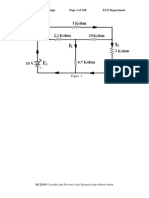3 The TTL NAND Gate
3 The TTL NAND Gate
Uploaded by
anupamj4uCopyright:
Available Formats
3 The TTL NAND Gate
3 The TTL NAND Gate
Uploaded by
anupamj4uCopyright
Available Formats
Share this document
Did you find this document useful?
Is this content inappropriate?
Copyright:
Available Formats
3 The TTL NAND Gate
3 The TTL NAND Gate
Uploaded by
anupamj4uCopyright:
Available Formats
3 The TTL NAND Gate
3.1 TTL NAND Gate Circuit Structure
The circuit structure is identical to the previous TTL inverter circuit except for the multiple emitter input transistor. This is used to implement a diode switching structure in active transistor form using parallel junction diffusions for several emitters.
Fig. 3.1 Multiple Input Emitter Structure of TTL If any input is low, the corresponding base-emitter junction becomes forward-biased and the transistor conducts. The other characteristics of the circuit and its transfer characteristic are identical to those of the inverter circuit.
3.2
Logical Operation
A table of conduction states can be drawn up showing the state of each transistor in the circuit for all possible input conditions as before to verify the logic function performed. The direction of conduction of T1 can be in the forward or reverse mode so this should also be noted in the table. It can be seen from the table that the output goes LO only when both inputs are HI which verifies the NAND function.
IN1 LO LO HI HI
IN2 LO HI LO HI
T1 ONfor ONfor ONfor ONrev
T2 OFF OFF OFF ON
T3 OFF OFF OFF ON
T4 ON ON ON OFF
D ON ON ON OFF
OUPUT HI HI HI LO
VCC
R3 R1 1. 6 k RB 4k 130
N5 N3
T4
N1
N6 N2
Input 1 Input 2
T1
T2
N4
R2
N7 T3
Output (no load)
1k
Fig. 3.2
Circuit Diagram of a Standard 2-input TTL NAND Gate
3.3. Circuit Analysis
It is of interest to examine the conditions for the different logic states of the NAND Gate circuit, particularly with regard to estimating the power consumption in each state. This can be done by first establishing the voltages at each of the nodes N1 N7 in the circuit and then finding the total current drawn from the power supply.
(a) At Least One Input LO Output HI To aid in the analysis, the NAND Gate circuit can be redrawn with the transistors which are non-conducting or OFF removed from the circuit as shown in Fig. 3.3. Then the potentials, relative to ground, can be determined for each of the nodes in turn. Under this condition, T1 is ON in forward mode, T2 is OFF, T3 is OFF, while T4 is ON at the point of cutin and therefore T2 and T3 have been removed from the circuit.
VCC IB I1
R1 RB 4k 1.6k
I3
R3 130
N5 N3 T4 N6
N1 Input 1 Input 2 0.1 V N2
T1
N4
R2 1k
N7
Output (no load)
Fig. 3.3
NAND Gate Circuit Redrawn with at least One Input LO
(i) T1 ON in forward mode and is operating in saturation as there is only a leakage current from T2 available as collector current, i.e. T1 operates with a large base current and negligible collector current where IC MAX = 0. The input logic LO voltage is taken as 0.1V. Then:
Node N1 : VN1 = Vi + VBE1 SAT = 0.1 + 0.8 = 0.9V
(ii) With T1 operating in saturation, its collector-emitter voltage is VCE SAT = 0.1V so that:
Node N2 : VN2 = Vi + VCE1 SAT = 0.1 + 0.1 = 0.2V
(iii) With T4 operating at the point of cut-in its base current and hence its collector current can be taken as zero. This means that there is no voltage drop across either resistor R1 or R3 and so the potential at both sides of these resistors is equal to the supply voltage VCC giving:
Node N3, Node N5 : VN3 = VN5 = VCC = 5V
(iv) Node N4 is pulled low by the resistor R2 which has no current flowing through it so that:
Node N4 :
(v)
VN4 = 0V
Finally, with T4 operating at the point of cut-in:
Node N6 : VN6 = VN3 VBE4 CUT-IN = 5 0.6 = 4.4V
and with the diode at cut-in also:
Node N7 : VN7 = VN6 VD CUT -IN = 4.4 0.4 = 4.0V
The current drawn from the supply can then be obtained as:
IB =
VCC VN1 5 0.9V = = 1.025mA RB 4k
with I1 and I3 = 0 since negligible current flows into the base or collector of T4 while at the point of cut-in. The power consumption of the gate with the output in the logic Hi state can then be obtained as:
POH = VCC x IB = 5V x 1.025mA = 5.125mW
(b) Both Inputs HI Output LO Under this condition T1 is ON in the reverse mode, T2 is ON, T3 is ON and T4 is OFF. Fig. 3.4 shows the NAND gate circuit redrawn with T4 removed. Potentials must be determined in a different order this time.
VCC
I1 IB
R1 1.6k RB 4k
I3
R3 130 N5
N3 N1 N6 N2 T2 N4
R2 1k
Input 1 Input 2
5V 5V
T1
N7 T3
Output (no load)
Fig. 3.4
NAND Gate Circuit Redrawn with Both Inputs HI
(i) With T3 ON and operating in saturation:
Node N4 : VN4 = VBE3 SAT = 0.8V
(ii) With T2 also ON and in saturation:
Node N2 :
VN2 = VN4 + VBE2 SAT = 0.8 + 0.8 = 1.6V
(iii) Since T1 is ON in the reverse mode, the base-collector voltage in this mode can be taken as the same as the base-emitter voltage of a transistor operating in the forward active mode so that:
Node N1 :
VN1 = VN2 + VBC1 ON REV = 1.6 + 0.7 = 2.3V
(iv) With T2 operating in saturation, its collector emitter voltage will be VCE SAT = 0.1V so that:
Node N3 :
VN3 = VN4 + VCE2 sat = 0.8 + 0.1 = 0.9V
(v) With T4 OFF no current will flow through resistor R3 and consequently Node N5 will be pulled up to the supply rail voltage:
Node N5 :
VN5 = VCC = 5V
(vi) With T3 ON and in saturation, its collector-base voltage will be at a saturation value so that the output voltage at Node N7 is simply:
Node N7 :
VN7 = VCE3 SAT = 0.1V
(vii) With T4 and the diode non-conducting, the potential at Node N6 is somewhat ill-defined and depends on the resistances of the nonconducting junctions of these devices but will lie somewhere between that of Nodes N3 and N7, i.e. between 0.1 and 0.9V. However, this voltage is not significant.
The current drawn from the supply this time is given by the sum of IB and I1 with I3 = 0: Then:
IB =
and
VCC VN1 5 2.3V = = 0.675mA RB 4k
I1 =
VCC VN3 5 0.9V = = 2.56mA R1 1.6k
The power consumption when the output is LO is then given as:
POL = VCC x (IB + I1 ) = 5 x ( 0.675 + 2.56) = 16.175mW
If the NAND gate is assumed to spend half of its time in each logic state then the average power consumption can be expressed as:
PAVE =
POH + POL 5.125 + 16.175 = = 10.56mW 2 2
You might also like
- Regenerative Agriculture - A Practical Whole Systems Guide To Making Small Farms Work by Richard PerkinsDocument766 pagesRegenerative Agriculture - A Practical Whole Systems Guide To Making Small Farms Work by Richard Perkinsmovieexplained2202100% (1)
- Nirvana and R Series 37kW-50HP To 250kW-300HP Modular Drive Troubleshooting Manual REV13 February 20121Document75 pagesNirvana and R Series 37kW-50HP To 250kW-300HP Modular Drive Troubleshooting Manual REV13 February 20121Eriton Cavalcanti100% (2)
- EC 2155 - Circuits and Devices Lab Manual Cum ObservationDocument108 pagesEC 2155 - Circuits and Devices Lab Manual Cum ObservationAnonymous uspYoqENo ratings yet
- Research Project Room Temperature Superconductors PDFDocument120 pagesResearch Project Room Temperature Superconductors PDFVladimir VoloshinNo ratings yet
- London EquationsDocument5 pagesLondon Equationsyehtt0212No ratings yet
- IO.5 Elliptically Polarized Light: 1. PurposeDocument5 pagesIO.5 Elliptically Polarized Light: 1. PurposeAaloka GautamaNo ratings yet
- Experiment 3: Bipolar Junction Transistor Characterization: 1 ObjectiveDocument3 pagesExperiment 3: Bipolar Junction Transistor Characterization: 1 Objectiveمحمد الاكحليNo ratings yet
- Ec2155 Lab ManualDocument32 pagesEc2155 Lab ManualProttoyNo ratings yet
- Experiment No.02 To Observe The Characteristics of A Half Wave RectifierDocument4 pagesExperiment No.02 To Observe The Characteristics of A Half Wave RectifierWaqas MughalNo ratings yet
- Star-Delta and Delta-Star TransformationsDocument19 pagesStar-Delta and Delta-Star TransformationsDossDossNo ratings yet
- FEE Lab Manual FinalDocument86 pagesFEE Lab Manual FinalbalasubadraNo ratings yet
- Dielectric Studies: Aim of The ExperimentDocument5 pagesDielectric Studies: Aim of The ExperimentAryan VermaNo ratings yet
- Unit-IV Bridges Syllabus: AC Bridges Measurement of Inductance-Maxwell's Bridge, Anderson BridgeDocument27 pagesUnit-IV Bridges Syllabus: AC Bridges Measurement of Inductance-Maxwell's Bridge, Anderson BridgeSwami Naidu GummadiNo ratings yet
- School of Engineering and Physics EE212 Lab 6Document4 pagesSchool of Engineering and Physics EE212 Lab 6Alvish NaiduNo ratings yet
- EDC Question BankDocument44 pagesEDC Question BankKRCT EEE HODNo ratings yet
- Bioelectrozi 1Document14 pagesBioelectrozi 1Cosmin ComanNo ratings yet
- Ferroelectric NotesDocument6 pagesFerroelectric Noteschvar80100% (1)
- AND GATE (7408) : A Y B Truth TableDocument14 pagesAND GATE (7408) : A Y B Truth TablepankajmadhuNo ratings yet
- Exp 5Document9 pagesExp 5Muhamad Fahim SadriNo ratings yet
- Lab 2 Report - EEX 4332Document42 pagesLab 2 Report - EEX 4332Chamaka PiyumalNo ratings yet
- LIC Lecture 3-Current Sources As Active Loads and Voltage Sources MaterialsDocument4 pagesLIC Lecture 3-Current Sources As Active Loads and Voltage Sources MaterialsMadhavan SamNo ratings yet
- Lab Requirements of Ece: Infrastructure Requirement As Per Aicte NormsDocument4 pagesLab Requirements of Ece: Infrastructure Requirement As Per Aicte NormsecessecNo ratings yet
- Four Probe Method-LabDocument23 pagesFour Probe Method-LabRajuNo ratings yet
- Lab Report#1Document8 pagesLab Report#1Nguyen TranNo ratings yet
- Assign Single Phase Ac-2 (Unit-2)Document4 pagesAssign Single Phase Ac-2 (Unit-2)Sunil JainNo ratings yet
- ECL 202 Analog Circuits and Simulation Lab: Course Information & Course PlanDocument10 pagesECL 202 Analog Circuits and Simulation Lab: Course Information & Course PlanleevasusanNo ratings yet
- CHAP 1 - Zener DiodeDocument65 pagesCHAP 1 - Zener Diodeksreddy2002No ratings yet
- EE6201 Circuit Theory Regulation 2013 Lecture Notes PDFDocument251 pagesEE6201 Circuit Theory Regulation 2013 Lecture Notes PDFrajNo ratings yet
- Experiment No:-07 DATE:24-09-20 Aim: To Realize Log and Antilog Amplifier Using Op-AmpDocument9 pagesExperiment No:-07 DATE:24-09-20 Aim: To Realize Log and Antilog Amplifier Using Op-AmpJainil ShahNo ratings yet
- Bridge Full Wave Rectifier - CheggDocument3 pagesBridge Full Wave Rectifier - Cheggsal27adamNo ratings yet
- NAS Lab ManualDocument25 pagesNAS Lab ManualPurvansh Jain100% (1)
- Simulation of Switching ConvertersDocument103 pagesSimulation of Switching ConvertersAshok KumarNo ratings yet
- Ujt Relaxaion OscillatorDocument2 pagesUjt Relaxaion Oscillatordinesh189100% (1)
- 5.AC Phase Control Using SCRDocument8 pages5.AC Phase Control Using SCRabcdefgNo ratings yet
- Verification of Norton's TheoremDocument1 pageVerification of Norton's TheoremDEVIL WISHER YTNo ratings yet
- Ferroelectricity: Spontaneous Dipole MomentDocument24 pagesFerroelectricity: Spontaneous Dipole Momentaliazab100% (2)
- Memristor Project ReportDocument17 pagesMemristor Project ReportVarun MallyaNo ratings yet
- 2.8.3 Torque Equation of Moving-Iron InstrumentsDocument3 pages2.8.3 Torque Equation of Moving-Iron Instrumentscleonie annissa100% (1)
- Lab 1 (1903069)Document6 pagesLab 1 (1903069)Tahsin Zaman TalhaNo ratings yet
- Comsats University Islamabad, Islamabad Campus: Lab Report # 12Document3 pagesComsats University Islamabad, Islamabad Campus: Lab Report # 12Armaghan AbidiNo ratings yet
- Chapter 1 - Introduction To Electric CircuitDocument100 pagesChapter 1 - Introduction To Electric Circuitalifzakaria446No ratings yet
- BEA LabExperiment 2Document3 pagesBEA LabExperiment 2Vikas Sharma0% (1)
- EDC Question BankDocument13 pagesEDC Question BankvenzkrishNo ratings yet
- Characteristics of Klystron TubeDocument9 pagesCharacteristics of Klystron TubeNeha SharmaNo ratings yet
- Class Test - 22423Document6 pagesClass Test - 22423Samadhan ThokalNo ratings yet
- Single Phase Half Wave Controlled ConverterDocument7 pagesSingle Phase Half Wave Controlled ConverterAlexNo ratings yet
- Diode Clippers: 1. Positive Clipper and Negative ClipperDocument6 pagesDiode Clippers: 1. Positive Clipper and Negative ClipperBibek ThapaNo ratings yet
- BEEE Unit 2-Single Phase Ac Circuits NotesDocument42 pagesBEEE Unit 2-Single Phase Ac Circuits NotesShreyash SargarNo ratings yet
- 5: Edser'S A' Pattern: Actual Setup: Https://Youtu - Be/Ruksrcv8Of0Document3 pages5: Edser'S A' Pattern: Actual Setup: Https://Youtu - Be/Ruksrcv8Of0Neelam KapoorNo ratings yet
- Laplace Transform ExamplesDocument19 pagesLaplace Transform Exampleshamza abdo mohamoudNo ratings yet
- Application of P-N Junction DiodeDocument3 pagesApplication of P-N Junction Diodevirendra.aryaNo ratings yet
- DielectricsAndFerroelectricsDocument29 pagesDielectricsAndFerroelectricsDante Filho100% (1)
- Ece 213 Lab Report 5Document8 pagesEce 213 Lab Report 5api-457533213No ratings yet
- Astable and Monostable Multivibrator Trainer NV6507Document10 pagesAstable and Monostable Multivibrator Trainer NV6507Himadri MandalNo ratings yet
- Module 1 - DESHIDocument93 pagesModule 1 - DESHIRaghupatiNo ratings yet
- SemiconductorsDocument89 pagesSemiconductorsPaapu TomNo ratings yet
- Optical ManualDocument26 pagesOptical ManualsharonfranklinNo ratings yet
- RC CircuitsDocument37 pagesRC CircuitsNoviNo ratings yet
- BJT PresentationDocument24 pagesBJT Presentationzakirece100% (1)
- Michelson PHYWE PDFDocument2 pagesMichelson PHYWE PDFLorran Neves100% (2)
- ET Lab ManualDocument47 pagesET Lab Manualdheeresh aggarwalNo ratings yet
- IntroductionDocument13 pagesIntroductionnokia58No ratings yet
- AC LIC-ManualDocument46 pagesAC LIC-Manualanupamj4uNo ratings yet
- Amit Compass4 13Document19 pagesAmit Compass4 13anupamj4uNo ratings yet
- Viva Questions For Analog Communication LabDocument2 pagesViva Questions For Analog Communication Labanupamj4u100% (1)
- Social-Based Trustworthy Data Forwarding in Vehicular Delay Tolerant NetworksDocument74 pagesSocial-Based Trustworthy Data Forwarding in Vehicular Delay Tolerant Networksanupamj4uNo ratings yet
- Broadcasting in VANET: Speaker: Lin-You WuDocument31 pagesBroadcasting in VANET: Speaker: Lin-You Wuanupamj4uNo ratings yet
- Vehicular Ad-Hoc Network, or VANETDocument3 pagesVehicular Ad-Hoc Network, or VANETanupamj4uNo ratings yet
- Introduction To Wireless CommunicationDocument12 pagesIntroduction To Wireless Communicationanupamj4uNo ratings yet
- Trigonometric Ind EntitiesDocument2 pagesTrigonometric Ind EntitiesSergio CabreraNo ratings yet
- Maxillary Premolars1Document54 pagesMaxillary Premolars1Parthvi ParmarNo ratings yet
- Total Audience Report q2 2017Document34 pagesTotal Audience Report q2 2017agnihoonNo ratings yet
- Edited and Updated Guide and Form Leadership AwardDocument9 pagesEdited and Updated Guide and Form Leadership AwardAehl KialNo ratings yet
- Book 3 - Road Safety at Work Site On Indonesian Roads MPWDocument98 pagesBook 3 - Road Safety at Work Site On Indonesian Roads MPWRahmadirgaNo ratings yet
- Acephob S - TMEDocument2 pagesAcephob S - TMEanneleiaaaNo ratings yet
- Dahua Marketing Material Guide - 20220418Document91 pagesDahua Marketing Material Guide - 20220418Antonio FormicaNo ratings yet
- Indiana Court of Appeal-Appellant's BriefDocument36 pagesIndiana Court of Appeal-Appellant's BriefKay KimNo ratings yet
- Section-I Index: SL. NO Content NODocument11 pagesSection-I Index: SL. NO Content NOsharmashalu14No ratings yet
- SpringBoot Assignment - Pravardhan SajjanDocument9 pagesSpringBoot Assignment - Pravardhan Sajjansupriyameghavath2001No ratings yet
- GQ - June 2015 AUDocument162 pagesGQ - June 2015 AUjtora100% (2)
- MC Tanque 15 Mil Bls Rev 02Document104 pagesMC Tanque 15 Mil Bls Rev 02maurizio109No ratings yet
- Schools Division Office of Isabela: 306117-San Mateo General Comprehensive High SchoolDocument2 pagesSchools Division Office of Isabela: 306117-San Mateo General Comprehensive High SchoolRoger Labuguen Anoling100% (1)
- Drug Study: Brokenshire CollegeDocument2 pagesDrug Study: Brokenshire CollegeJai GoNo ratings yet
- MSDS Developer SDSDocument10 pagesMSDS Developer SDSEndah SumiyaningsihNo ratings yet
- Dr. Vinod CVDocument2 pagesDr. Vinod CVVinodNo ratings yet
- Biology Matters Theory Workbook 1Document196 pagesBiology Matters Theory Workbook 1same faaz100% (1)
- CSTP 4 OloughlinDocument5 pagesCSTP 4 Oloughlinapi-679108380No ratings yet
- Joe Orton and The Redefinition of Farce (By Joan F Dean)Document13 pagesJoe Orton and The Redefinition of Farce (By Joan F Dean)Nora LerubNo ratings yet
- KeyforlearningcheckonDocument1 pageKeyforlearningcheckonapi-284378116No ratings yet
- Summary Sheet R-PAS Admin and ClarificationDocument2 pagesSummary Sheet R-PAS Admin and ClarificationMarina SwansonNo ratings yet
- Flexeasy: Product BenefitsDocument2 pagesFlexeasy: Product BenefitsmanishaliveNo ratings yet
- Esquema Principal de 3500 Cat PDFDocument2 pagesEsquema Principal de 3500 Cat PDFClever Negrete NovaNo ratings yet
- 7TV 2 PFDocument111 pages7TV 2 PFFerg Hadley100% (1)
- Birds of KuwaitDocument418 pagesBirds of KuwaitHarsh Tiwari80% (5)
- Maipu MannualDocument12 pagesMaipu MannualKazi BarakatNo ratings yet
- Chigbo Chibuikem K21PPDocument11 pagesChigbo Chibuikem K21PPAbootlhaNo ratings yet
- Modes of Integrative TeachingDocument29 pagesModes of Integrative TeachingAraja Chescky R. BSE-1ENo ratings yet
- Examen de Inglés IntermedioDocument5 pagesExamen de Inglés IntermedioaarmeridadiazNo ratings yet

































































































